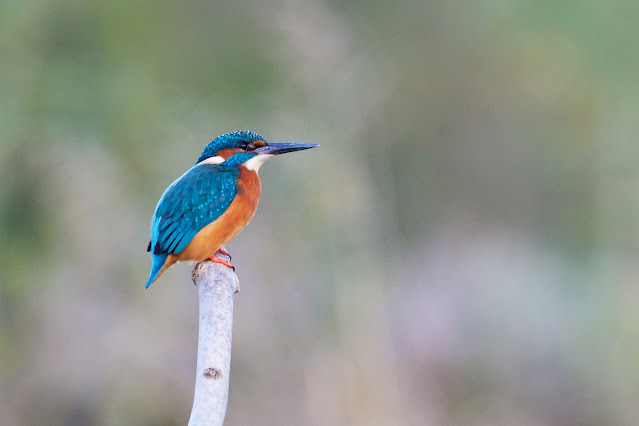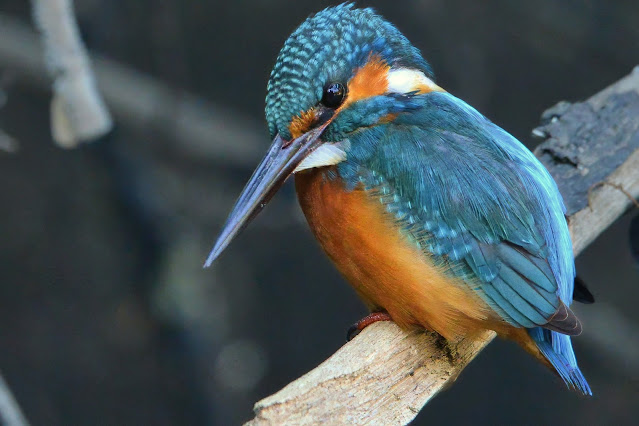Bird Stories - Interesting Facts - Common Kingfisher
I have been photographing, watching and observing Common Kingfisher छोटा किलकिला, राम चिरैया, शरीफन, निता मछराला (Alcedo atthis) for almost 8 years now. Over this time I have learned a few facts, observed some interesting behavior, and read a lot. Sharing some of these here:
.jpg) |
| Common Kingfisher छोटा किलकिला, राम चिरैया, शरीफन, निता मछराला (Alcedo atthis) |
1. How to differentiate between Male & Female?
Both sexes of Common Kingfisher look very similar, females are slightly smaller than males. But the magic is in the mandible (bill or beak), males have all-black upper and lower mandibles while females have conspicuous orange lower mandibles. Obviously, females love to put lipstick on. It is hard to differentiate sexes in juveniles, they develop color in mandible only after a year or so.
.jpg) |
| Male & Female Common Kingfishers with fish for the chicks |
2. How to differentiate juveniles from Adults?
There are two ways to differentiate between Common Kingfisher juvenile and an adult - the color of their legs is brownish, not bright orange, and the tip of their bill is white (indeed fluorescent). My observation is that their beak is slightly shorter and bulkier as well, but I was challenged by a few fellow birders. Also, the color of the lower mandible switches between orange and black as the juvenile matures.
3. Whether fish is to eat or to give?
Both parents of Common Kingfisher छोटा किलकिला, राम चिरैया, शरीफन, निता मछराला (Alcedo atthis) share the responsibility to feed the chicks. Both parents share the responsibility to incubate the first clutch and the next broods are incubated by females; once hatched parents fetch fish for the young ones throughout the day. After catching the fish, if it is to be consumed, Kingfisher will align the fish along the bill with the fish's head inwards and if it is supposed to be given to a partner or chick then the head of the fish is aligned outwards. In either case, Kingfishers brutally kill their catch by smacking them left and right on the perch.
 |
| Female Common Kingfisher with fish to be fed to chicks |
4. Are Common Kingfisher छोटा किलकिला, राम चिरैया, शरीफन, निता मछराला (Alcedo atthis) social?
Like all other species of Kingfishers, Common Kingfishers are also solitary and territorial. They will chase any other male, female, or juvenile away from their territory. The size of the territory depends on the amount of fish available around, it can vary from a few hundred meters to a few kilometers. At RSPB Rye Meads, there are two active nesting banks just a couple of hundred meters apart, which is a bit unusual and can only be attributed to the fact that a lot of fish is available in nearby river Lea. It is commonly observed that juvenile is chased away within a day after they fledge. Indeed they are chased away by dad aggressively so that, Dad can possibly have another brood.
.jpg) |
| Common Kingfisher छोटा किलकिला, राम चिरैया, शरीफन, निता मछराला (Alcedo atthis) |
 |
| Common Kingfisher छोटा किलकिला, राम चिरैया, शरीफन, निता मछराला (Alcedo atthis) |
5. What is the color of their feathers?
This is very interesting, under different light conditions, and depending on the age of the kingfisher appearance of the kingfisher changes from blue, azure, violet, or greenish - but a matter of fact is that their feathers are brown-orange.
6. Why do Common Kingfisher छोटा किलकिला, राम चिरैया, शरीफन, निता मछराला (Alcedo atthis) dives or rinse after coming out the nest?
The nest of Common Kingfishers is very dirty and unsanitary. They make nests in tunnels dug in vertical sandy or earthen banks. In order to keep their feathers tidy and healthy, immediately after coming out of the nest they take a dip and prune their feathers.
 |
| Common Kingfisher maintaining its feathers |
7. How do Common Kingfishers see in the water while fishing?
Common Kingfisher has special eyes, they have a monocular vision in the air and binocular vision underwater, this is how they catch the fish by perfectly managing and adjusting their vision for refraction. When the Common Kingfisher is underwater, it protects its eyes by closing nictating membrane. Similar to other diving birds like Cormorants, Common Kingfisher has a transparent window in nictating membrane which enables them to see underwater. Isn't it amazing?
 |
| Common Kingfisher with fish immediately after the dive. |
8. Why does Common Kingfisher vomit?
Throughout the day Common Kingfishers will regurgitate small pellets of fish bones and anything that they are not able to digest. The interesting point is that chicks don't vomit the pellets out, it is because they have a very acidic digestive system that dissolves everything. It takes chicks 3-4 weeks to develop the non-acidic digestive system.
9. How do Common Kingfisher chicks look like?
Common Kingfisher's chicks are a very ugly pink-orangish lump of meat. But as they grow and develop they fledge as beautiful birds. Another interesting fact is that Common Kingfisher's chicks have fluorescent-tipped bills. This help adults in feeding the chick in dark and filthy nests.
10. How long does it take Common Kingfisher to hatch and fledge?
It roughly takes 19-20 days to hatch and about 23-25 days for chicks to leave the nest. Common Kingfisher's first clutch has around 6-7 chicks and each eats about 20 fish every day. That's a lot of fish for parents to catch !!!
11. Are Common Kingfishers very common across the globe?
Common Kingfishers are the most widely distributed species of Kingfishers. There are about 100 species of Kingfishers found on 6 continents. Common Kingfishers are found in Europe, Northern Africa, Asia - the Middle East to South to South East - Japan, and on some of the Pacific Islands near Australia. Not found in the Americas or Australia. Throughout the range, there are 7 sub-species of Common Kingfishers recorded, which varies in size by 10-12% and vibrancy of colors.
.jpg) |
| Common Kingfisher छोटा किलकिला, राम चिरैया, शरीफन, निता मछराला (Alcedo atthis sspA. a. ispida) RSPB Rye Meads July 2022 |
Blog: Birds Around Me 0083 - Common Kingfisher छोटा किलकिला, राम चिरैया, शरीफन, निता मछराला (Alcedo atthis) - https://birds.rekabira.in/2017/12/birds-around-me-0083-common-kingfisher.html
My unfinished List of Birds (पक्षियों की अपूर्ण सूची): https://birds.rekabira.in/p/this-is-list-of-birds-i-clicked-since.html
-- Ashutosh Jhureley @BirdsAroundMe


.jpg)

Comments
Post a Comment